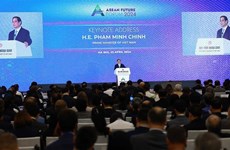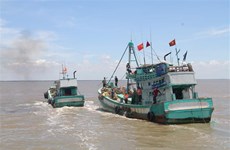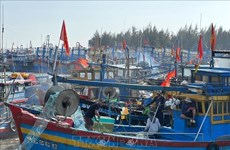Experts, architects suggest ideas for HCM City metro area
Experts and architects put ideas forwards to develop the HCM City
metropolitan area at a recent conference entitled “Planning-altering
ideas for developing HCM City metropolitan zone by 2030 with a vision to
2035.”
Experts and architects put ideas forwards to develop the HCM City
metropolitan area at a recent conference entitled “Planning-altering
ideas for developing HCM City metropolitan zone by 2030 with a vision to
2035.”
Tran Ngoc Chinh, president of Vietnam Urban Planning and Development Association (VUPDA), said that the HCM City metropolitan area must have a clear development boundary in order to take advantage of topology, land and landscape.
The metropolitan expansion should head towards the sea as well as establishing a network of towns connecting to the nuclear city and in return, those towns got benefits from the nuclear city, Chinh added.
The HCM City metropolitan area with HCM City as the nuclear city is planned to encompass the borders of the current HCM City and seven surrounding provinces – Binh Duong, Dong Nai, Binh Phuoc, Long An, Tay Ninh, Ba Ria-Vung Tau and Tien Giang.
The natural area of the zone is around 30,404 sq. km and has a population of 18 million. It is to contribute 60 percent of the State budget revenue and over 70 percent of the entire country’s export volume, according to architect Ngo Quang Hung from the Southern Construction Planning Institute.
The participants agreed that the planning adjustment is necessary to improve the metropolitan zone’s role and position in the world as well as boosting the connection with large metropolitan zones in Southeast Asia and South Asia.
The adjustment also helps overcome shortcomings in the development of the zone’s space, increasing the regional connection and integration with the overall planning on socio-economic development as well as meeting challenges from climate change.
Hung also suggested the layout for economic areas in the metropolitan zone with HCM City as the nuclear city, serving as an economic, industrial, scientific and technological centre, while the Northwest region, including Tay Ninh and Binh Phuoc, will develop border-gate economy and highly-specialized agriculture.
The Northeast region, composed of Dong Nai, Binh Duong and Ba Ria - Vung Tau, will develop logistics service, ecological and resort tourism and the Southwest region, including Long An and Tien Giang, will be the area specialising in growing rice, fruit trees, and raising seafood.
Professor Charles Gore, an economic expert from the United Nations Conference on Trade and Development, underscored the role of the HCM City metropolitan zone region, considering the region as a way of helping Vietnam beat the middle-income trap.
Meanwhile, Professor Frank Schwartze from Germany pointed out problems likely facing HCM City such as too many unoccupied departments, worsening flooding and traffic congestion.
Architect Ngo Viet Nam Son, a specialist on urban planning, put an emphasis on two challenges the city is facing: the uncontrolled and unsustainable urbanisation and risks of climate change and rising sea levels.
According to Son, the metropolitan area should prioritize developing a network of roads and highways as well as multi-sector and inter-regional cooperation mechanisms.
Huynh The Du, lecturer of the Fulbright Economics Teaching Programme, said it was necessary to share responsibilities and gains among provinces and cities within the metropolitan region.
The conference was held in the City on December 19.-VNA
Tran Ngoc Chinh, president of Vietnam Urban Planning and Development Association (VUPDA), said that the HCM City metropolitan area must have a clear development boundary in order to take advantage of topology, land and landscape.
The metropolitan expansion should head towards the sea as well as establishing a network of towns connecting to the nuclear city and in return, those towns got benefits from the nuclear city, Chinh added.
The HCM City metropolitan area with HCM City as the nuclear city is planned to encompass the borders of the current HCM City and seven surrounding provinces – Binh Duong, Dong Nai, Binh Phuoc, Long An, Tay Ninh, Ba Ria-Vung Tau and Tien Giang.
The natural area of the zone is around 30,404 sq. km and has a population of 18 million. It is to contribute 60 percent of the State budget revenue and over 70 percent of the entire country’s export volume, according to architect Ngo Quang Hung from the Southern Construction Planning Institute.
The participants agreed that the planning adjustment is necessary to improve the metropolitan zone’s role and position in the world as well as boosting the connection with large metropolitan zones in Southeast Asia and South Asia.
The adjustment also helps overcome shortcomings in the development of the zone’s space, increasing the regional connection and integration with the overall planning on socio-economic development as well as meeting challenges from climate change.
Hung also suggested the layout for economic areas in the metropolitan zone with HCM City as the nuclear city, serving as an economic, industrial, scientific and technological centre, while the Northwest region, including Tay Ninh and Binh Phuoc, will develop border-gate economy and highly-specialized agriculture.
The Northeast region, composed of Dong Nai, Binh Duong and Ba Ria - Vung Tau, will develop logistics service, ecological and resort tourism and the Southwest region, including Long An and Tien Giang, will be the area specialising in growing rice, fruit trees, and raising seafood.
Professor Charles Gore, an economic expert from the United Nations Conference on Trade and Development, underscored the role of the HCM City metropolitan zone region, considering the region as a way of helping Vietnam beat the middle-income trap.
Meanwhile, Professor Frank Schwartze from Germany pointed out problems likely facing HCM City such as too many unoccupied departments, worsening flooding and traffic congestion.
Architect Ngo Viet Nam Son, a specialist on urban planning, put an emphasis on two challenges the city is facing: the uncontrolled and unsustainable urbanisation and risks of climate change and rising sea levels.
According to Son, the metropolitan area should prioritize developing a network of roads and highways as well as multi-sector and inter-regional cooperation mechanisms.
Huynh The Du, lecturer of the Fulbright Economics Teaching Programme, said it was necessary to share responsibilities and gains among provinces and cities within the metropolitan region.
The conference was held in the City on December 19.-VNA













